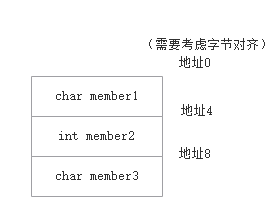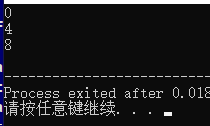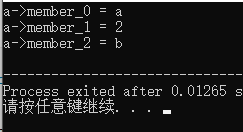

container_of()宏,太妙了~
描述
container_of(ptr, type, member)宏的作用
该宏的作用是通过结构体成员的地址和结构体类型推导出结构体的地址,type是指结构体的类型,member是成员在结构体中的名字,ptr是该成员在type结构体中的地址。
container_of(ptr, type, member)宏解析
在 linux 源码的 toolsincludelinuxkernel.h文件下,container_of()的定义如下:
#ifndef container_of
/**
* container_of - cast a member of a structure out to the containing structure
* @ptr: the pointer to the member.
* @type: the type of the container struct this is embedded in.
* @member: the name of the member within the struct.
*
*/
#define container_of(ptr, type, member) ({
const typeof(((type *)0)->member) * __mptr = (ptr);
(type *)((char *)__mptr - offsetof(type, member)); })
#endif
在 container_of() 宏的定义中的 offsetof(TYPE, MEMBER) 和 typeof() 初学者可能会对其很陌生,所以我们要先从理解 offsetof(TYPE, MEMBER) 和 typeof() 的作用开始。
offsetof(TYPE, MEMBER)
本质也是个宏定义,在 linux 源码的 toolsincludelinuxkernel.h 文件下定义如下:
#ifndef offsetof
#define offsetof(TYPE, MEMBER) ((size_t) &((TYPE *)0)->MEMBER)
#endif
offsetof 宏中的 TYPE 是指结构体的类型,MEMBER 是指结构体中的某个成员,作用是求出该成员的在该结构体中的偏移量。该宏首先将 0 (地址0)转化为 TYPE * 的结构体指针,表示地址为 0 的结构体指针,然后通过取地址符 &((TYPE *)0)->MEMBER) 取出该结构体指针中 MEMBER 成员的地址,最后再将地址值强转为 size_t 类型(内核中为 unsigned long 类型)即表示 MEMBER 成员在结构体中的偏移量。要理解该过程需要了解对结构体的内存分布,如图,结构体的内存分配是连续的,当结构体的地址为0时,成员的地址即为该成员的偏移量。

实例:
#include
输出:

typeof()
typeof() 是 GNU C 中的一个关键字,和 sizeof() 一样都是 C 语言中的关键字而不是函数。作用是返回传入数据的类型。实例:
#include
输出:

container_of(ptr, type, member)
了解了 offsetof() 宏和 typeof 关键字之后就比较好理解 container_of 宏的作用了。
const typeof(((type *)0)->member) * __mptr = (ptr)
该代码的作用实际上是将 0 转化为 type * 结构体类型,再取出结构体中的MEMBER成员 (type *)0)->member, 再通过 typeof 关键字获取 MEMBER 成员的类型,并定义一个 MEMBER 成员类型的指针 const typeof(((type *)0)->member) * __mptr,将传入的 ptr 指针赋值给 __mptr__mptr = (ptr)。
(type *)((char *)__mptr - offsetof(type, member));
该代码是将获取的 MEMBER 成员地址强转为 char *(强转的目的是考虑指针的加减的实质是指针在内存的偏移,偏移量为指针类型所占字节的个数),减去 MEMBER 成员在 type 结构体中的偏移量,强转为 type * 后得到结构体的地址。实例:
#include
输出:

-
详细聊聊container_of这个宏定义2023-11-13 1296
-
Linux内核中container_of原理详解2023-07-14 763
-
Linux内核中的宏/container_of分析2023-06-23 780
-
Missing Container Metrics容器指标收集工具2022-05-12 442
-
Ansible Container容器自动化构建部署工具2022-05-11 470
-
Accelerated Container Image基于块设备的容器镜像加速服务2022-05-10 877
-
鸿蒙应用开发-container动漫效果体验2021-04-09 772
-
Labview Active Container引用AUTODESK控件后异常?2020-05-19 2182
-
Linux内核基础-container_of2019-05-14 996
-
offsetof宏与container_of宏详解2017-10-13 3574
-
揭开linux内核中container_of的神秘面纱2016-11-11 4157
全部0条评论

快来发表一下你的评论吧 !

